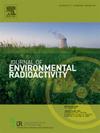裂隙-孔隙覆盖层隧道中氡运移的CFD模拟与控制
IF 2.1
3区 环境科学与生态学
Q3 ENVIRONMENTAL SCIENCES
引用次数: 0
摘要
在地下工程中,通常建立覆盖层,为地下隧道提供一定的支撑和保护。同时,覆盖层还能抑制围岩的氡析出。为了研究隧道覆盖层和围岩中的氡释放,并控制裂隙-孔隙覆盖层隧道中的氡运移,选取了某地下隧道进行分析。建立了裂隙-孔隙介质中氡运移动力学模型,并进行了计算流体力学(CFD)模拟,分析了覆盖层和围岩中氡的释放过程。考察了压差、扩散系数、透气性等因素对氡呼出率的影响。结果表明,调整这些参数可以有效地控制氡的释放速率,其中主动降压(AD)方法可以显著降低氡的释放速率,为地下工程氡污染的控制提供科学依据。本文章由计算机程序翻译,如有差异,请以英文原文为准。
CFD simulations and control of radon migration in tunnels with fracture-pore covered layers
In underground engineering, a covered layer is usually established to provide certain support and protection for underground tunnels. At the same time, the covered layer can also inhibit radon exhalation from surrounding rock. To study radon exhalation in the covered layer and surrounding rock of a tunnel, and to control radon migration in tunnels with fracture-pore covered layers, a specific underground tunnel was chosen for analysis. A radon migration and dynamics model in the fracture-pore medium was developed, and computational fluid dynamics (CFD) simulations were performed to analyze the radon exhalation from the covered layer and surrounding rock. The impact of factors like pressure difference, diffusion coefficient, and permeability on the radon exhalation rate was examined. The results indicated that adjusting these parameters could effectively manage the radon exhalation rate, with a particular focus on the proposed active depressurization (AD) method, which can significantly reduce the radon exhalation rate and provide scientific basis for radon pollution control in underground engineering.
求助全文
通过发布文献求助,成功后即可免费获取论文全文。
去求助
来源期刊

Journal of environmental radioactivity
环境科学-环境科学
CiteScore
4.70
自引率
13.00%
发文量
209
审稿时长
73 days
期刊介绍:
The Journal of Environmental Radioactivity provides a coherent international forum for publication of original research or review papers on any aspect of the occurrence of radioactivity in natural systems.
Relevant subject areas range from applications of environmental radionuclides as mechanistic or timescale tracers of natural processes to assessments of the radioecological or radiological effects of ambient radioactivity. Papers deal with naturally occurring nuclides or with those created and released by man through nuclear weapons manufacture and testing, energy production, fuel-cycle technology, etc. Reports on radioactivity in the oceans, sediments, rivers, lakes, groundwaters, soils, atmosphere and all divisions of the biosphere are welcomed, but these should not simply be of a monitoring nature unless the data are particularly innovative.
 求助内容:
求助内容: 应助结果提醒方式:
应助结果提醒方式:


